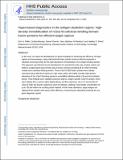Paper-based diagnostics in the antigen-depletion regime: High-density immobilization of rcSso7d-cellulose-binding domain fusion proteins for efficient target capture
Author(s)
Miller, Eric A; Baniya, Subha; Osorio, Daniel; Al Maalouf, Yara Jabbour; Sikes, Hadley D
DownloadAccepted version (672.9Kb)
Publisher with Creative Commons License
Publisher with Creative Commons License
Creative Commons Attribution
Terms of use
Metadata
Show full item recordAbstract
© 2017 Elsevier B.V. In this work, we report the development of a general strategy for enhancing the efficiency of target capture in immunoassays, using a bifunctional fusion protein construct which incorporates a substrate-anchoring moiety for the high-abundance immobilization of an antigen-binding domain. This approach was informed by the development of a pseudo first-order rate constant model, and tested in a paper-based assay format using a fusion construct consisting of an rcSso7d binding module and a cellulose-binding domain. These rcSso7d-CBD fusion proteins were solubly expressed and purified from bacteria in high molar yields, and enable oriented, high-density adsorption of the rcSso7d binding species to unmodified cellulose within a 30-second incubation period. These findings were validated using two distinct, antigen-specific rcSso7d variants, which were isolated from a yeast surface display library via flow cytometry. Up to 1.6 micromoles of rcSso7d-CBD was found to adsorb per gram of cellulose, yielding a volume-averaged binder concentration of up to 760 μM within the resulting active material. At this molar abundance, the target antigen is captured from solution with nearly 100% efficiency, maximizing the attainable sensitivity for any given diagnostic system.
Date issued
2018Department
Massachusetts Institute of Technology. Department of Chemical EngineeringJournal
Biosensors and Bioelectronics
Publisher
Elsevier BV